As anticipation builds for the next generation of iPhone, the rumor mill is abuzz with talks of substantial upgrades slated for the upcoming iPhone 17 series. Specifically, the Pro models are expected to not only grow in size but also introduce a revolutionary display technology that could redefine mobile user experiences.
In what could be a significant technological leap, the iPhone 17 Pro models might say goodbye to the current Low-Temperature Polycrystalline Oxide (LTPO) display panels. Taking their place could be the new Low-Dielectric TEE technology, as tipped by noted leaker Jukanlosreve on the social media platform X. This new display tech promises to sit beneath the OLED panel and bring forth improvements in battery efficiency, durability, and overall performance.

Jukanlosreve highlights that this advancement “improves battery efficiency, maximizes display durability, and enhances overall performance compared to existing display technologies.” This statement underscores the potential of Low-Dielectric TEE technology to elevate the iPhone’s capabilities, ensuring that the device is not only more power-efficient but also robust enough to withstand the rigors of daily use.
Design and Hardware Upgrades
Alongside the display technology overhaul, the iPhone 17 Pro and Pro Max are rumored to feature a design mix of aluminum and glass on the back panel to support wireless charging better. Notably, the camera setup is expected to become more prominent, occupying a larger area with a rectangular bump.
The hardware specifications are also rumored to receive a boost, with enhancements including a smaller Dynamic Island, a bump up to 12GB of RAM, a 24MP front camera, and the powerful A19 Pro 3nm chipset. These upgrades would undoubtedly make the iPhone 17 Pro a considerable leap forward from its predecessors.

Connectivity Innovations
Adding to the excitement, industry analyst Ming-Chi Kuo reports that Apple might also introduce proprietary Wi-Fi and Bluetooth chips in the 2025 iPhone lineup. Produced by Apple’s long-time partner TSMC using the N7 process, these chips are expected to optimize connectivity performance further.
Material Choices: Sticking with Titanium
Recent speculations suggest that Apple will continue to use a titanium chassis for the iPhone 17 Pro models, moving away from the aluminum chassis used in previous models. This choice not only contributes to the device’s aesthetic and durability but also its premium feel.

What’s Next?
Before we get to see the iPhone 17 series in all its glory, Apple is expected to launch the iPhone SE 4 in March 2025. This model is eagerly awaited by those looking for a powerful yet more accessible version of Apple’s technology.
As we edge closer to the release dates, the tech community and Apple enthusiasts alike are keen to see how these rumored features will translate into reality. If these upgrades hold true, the iPhone 17 Pro and Pro Max could set new standards for what users expect from their smartphones, marking another milestone in Apple’s legacy of innovation.










